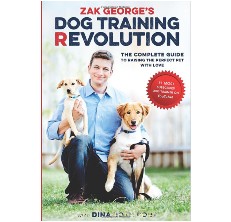- Home
- Gear Categories

We independently research, test, review, and recommend the best products - learn more about our process here. If you buy something through our links, we may earn a commission.
Teach Your Dog With the Best Dog Training Books
Last updated: 8 Jan 2024
One of the most important responsibilities of a new dog owner is to make sure their dog is properly trained. It can be overwhelming to plan training, teach obedience, housebreaking, and socialization to a new dog or a small puppy. Dog training books will guide you through the basics of owning a dog, such as proper feeding, necessary vaccinations, deworming, and teaching commands to understand complex behaviors. These thoroughly researched books by experts are the most trustworthy source to learn about your canine friend.
Every dog parent would prefer training advice from a science-based source such as a professional dog trainer, rather than from a self-taught dog whisperer on YouTube. And since your dog doesn’t come with a guidebook or an instruction manual, you need to get your hands on a high quality training book. We reached out to some esteemed trainers and behavioral experts for some recommendations of the greatest dog training books in 2024, and have created a list of their top picks.
Show contents
Best Dog Training Books Buying Guide
Here’s a brief guide that covers everything you should know when buying a book for training dogs.
Methods of Training a Dog
There are two common methods for training dogs. Various dog training books will use one of the two methods.
Aversive-Based Training
The aversive-based or discipline-based training method involves the use of negative reinforcement and positive punishment techniques to teach your dog. This technique uses physical and verbal corrections, loud scolding, and other unpleasant interactions to basically “scare” a dog into obeying you and acting the way you want. This method leaves your dog strictly trained to fear you to avoid pain.
Reward-Based Training
The reward-based method uses encouragement and positive reinforcement theory to train your dog to continue a certain behavior. You use treats to reward them for the actions and behaviors you want them to continue. Rewards could include belly rubs, treats, toys, or other pleasing activities that reinforce good behavior. This method lets your dog associate a happy feeling with the idea of doing what they’re told to do.
Tips for First Time Dog Owners
Here are some useful tips for all soon-to-be dog parents:
Research your dog
A significant part of your “dog prep” is to understand what your dog will be requiring both mentally and physically. A new dog will be completely reliant on the owner; the quality of life they have will depend solely on how you treat and keep them.
Research the breed you’re getting or want to get, their common behavior, lifespan, and any ailments they are prone to. Read dog training books from certified trainers and professionals to learn dog training techniques and exercises the right way.
Prepare your house
Always dog-proof the house for both your dog’s wellbeing and your own sake. You should have all the basics before your furry friend arrives. This includes bowls, leash, collar, toys, litter box, and the appropriate sleeping space.
Patience and training
You need to stay very patient for the first few days and give the new dog space to explore and get familiar with his or her new surroundings. Dogs coming from shelters or older fellows often have a hard time trusting their new parents – you need to provide a relaxing environment for them to feel secure.
Practice positive reinforcement and stay patient when teaching them house rules and new behavior control. Develop their daily routines slowly, allowing them to settle, accept and learn.
Find a vet
One of the most stressful places for a dog could is the veterinarian’s office. You need your dog to develop a positive relationship with the vet. You should find a vet beforehand to get your new dog checked as soon as you get him or her. Be sure to learn all about vaccination and deworming schedules.
Budget
Owning and raising a dog is a big commitment. There are some monthly, bi-annual, and annual expenses that you will have to bear with the dog. For a healthy dog, you will have to buy good quality food, purchase flea, tick, and heartworm preventatives, provide treats, go for checkups, pay for grooming, and get them vaccines often. You should consider if you can stretch your budget to prepare and keep up with these expenses.
Tips for Raising a Dog at Home
When you bring a new dog at home, you and your dog both will be going through several changes and adjustments. Here’s how you can deal with them:
Develop trust
You can develop a bond of trust with your new furry buddy through simple activities like feeding, walking, bathroom breaks, giving treats, and playtime. Establish a routine and spend as much time with them as you can to build a strong relationship. Train your dog to communicate with you and strangers as well. Routine builds trust and consistency which helps them to learn to rely on you for their happy time.
Understand their dietary requirements
If you’re getting a puppy, make sure you’re aware of their food requirements at different stages of life, such as during the weaning period and after their new teeth come in. Figure out if you’ll be feeding them commercial food or homemade food.
Puppies need a more protein and fat-based diet, which is why feeding them puppy-formulated pet food is the best option. These blends have the right amount of carbohydrates, fats, proteins, vitamins, and minerals that your dog needs for growth. A common mistake is feeding them treats excessively; you should always keep their weight and diet portions in check with the vet.
Training
Start your dog’s training from day one. Decide beforehand the kind of training methods, commands, and language you will be using. Establish what is allowed and what isn’t from the very first day. Teach them boundaries and reward good behavior with belly rubs and treats. Make sure you plan sufficient playtime during the day so they don’t feel neglected. Understand the kinds of actions your dog exhibits to get your attention and work with them.
Socializing
Make sure you’re ready to introduce your dog to the world of humans and dogs outside the house. Once your puppy is at least sixteen weeks old and has all of their vaccinations, you can start taking them to a dog park. This will help teach them how not to bite or fight with other animals around. Make sure you find the right dog park according to their breed and size.
What Should You Train Your Dog for?
Training a dog is not as simple as teaching them to sit or do a trick for you. It’s a long process of establishing patterns and schedules. Here is a list of some of the actions, activities, and commands you should train your dog for:
- Train your dog from day one to walk on a leash with you so they can learn how not to lunge or pull when walking alongside you.
- Clicker train your dog for commands and actions.
- Housebreak or potty train your dog.
- Crate train them to make future vet visits a lot less stressful.
- Socializing helps them better accept new people and dogs.
The best dog training books will provide you with guidance on these topics, as well as other tips for establishing a strong and trusting bond between you and your dog.
Conclusion
There are a lot of considerations to keep in mind before you bring your new four-legged friend home. Make sure you’re ready for everything they would need to live a happy life with you. This includes not only preparing your house for them but also preparing yourself to train your dog.
Experienced trainers and veterinarians suggest guides and training books to help you make more sense of your dog’s life. We have picked some of the best dog training books in 2024 for you so you can teach your dog how to behave around you.
Five Best Dog Training Books in 2024
1
Zak George Dog Training Revolution
– Best OverallTHE SCOOP
Including a wealth of practical tricks, games, and useful tips, this dog training book is a complete guide for both new and experienced dog owners. This book explains all the details of house training for all kinds of dogs, plus gives detailed ways to train specific to your pup’s breed. From the basics like “sit,” “leave it,” or “look at me,” to decoding complicated behavioral issues, this book will help you with it all.
The guide suggests training your dog according to his or her unique energy levels and traits. It discourages punishment-based training and the dominance theory that teaches that intimidation is the only way to teach a dog. It also suggests the kind of dog you should pick if you’re planning to get one, and gives information on their grooming, socialization, and health needs.
Pros
- Provides a guide to dog-proofing your home
- Troubleshoots ideas for behavioral problems
- Checklists for emergency situations and care
Cons
- Focuses on house training only
2
How to Raise the Perfect Dog
– Runner UpTHE SCOOP
This book has been written by Cesar Millan, a bestselling author and star of the popular National Geographic show Dog Whisperer. He is the preeminent expert in all issues relating to a dog’s behavior, from puppyhood and beyond. The book explains the best practices and ways to raise a dog to prevent behavioral issues as they grow up.
The book is filled with tips and tricks for correcting behavioral issues before they become a habit and cause a problem. There are checklists and timelines, explaining how you can avoid the common mistakes from the very first day by setting boundaries, creating rules, and by establishing your dominance gently and appropriately.
Pros
- Tips for proper nutrition at all stages of a dog’s life
- All you need to know about vaccination and over-vaccination
- Teaching dog owners calm-assertive leadership
Cons
- Some users found the title misleading; doesn’t include instructions
3
Puppy Training in 7 Easy Steps
– Honorable MentionTHE SCOOP
This book by Mark Van Wye tells you everything you need to know to raise a perfect, well-mannered dog. The book comes with step-by-step guides and instructions that explain how you can combine calm-assertiveness and positive reinforcement with a dog’s natural instincts. It explains how you can define and teach boundaries to your dog and establish a bond of trust with them.
The training fundamentals are built around your pup’s skills at every stage of their growth. The book helps you train yourself along with the dog to tolerate frustration, patiently teach, and establish discipline. It has insights that help you understand your puppy’s behavior, perspective, and body language.
Pros
- Puppy-proofing and prep instructions
- Troubleshooting and tips
- Key identification checklists for sickness and behavior issues
Cons
- Not very detailed
4
Lucky Dog Lessons Training Book
– Also ConsiderTHE SCOOP
Written by Brandon McMillan, an Emmy-winning CBS show star, this book contains all the guidelines needed to train a puppy from day one or to transform a spoiled puppy into a well-behaved boy or girl. The book includes training systems that can change your dog’s behavior in just seven days.
This guide works for all kinds of dog breeds and has lessons for pups of every age. From covering the basics like establishing focus and building trust to mastering tricks and techniques, this is a complete step-by-step instruction guide to training your furry friend. There are solutions to common canine behavioral issues with illustrative examples and tried-and-tested tips.
Pros
- An in-depth explanation for common dog behavior
- Inspiring stories about challenging encounters
- Proven techniques and streamlined training lessons
Cons
- Most solutions in the book require purchasing some sort of dog equipment
THE SCOOP
Authors of the classic How to Be Your Dog’s Best Friend, the Monks of New Skete have released a new edition of their dog training and behavior management book. It contains updated content based on the latest research and authority establishment styles.
The book explains techniques and processes with the help of illustrations and pictures. There are separate, detailed chapters on crate training, playing, raising, and training canines in an urban environment. The tips shared are double-checked with the latest health and canine behavioral theories. The book also includes an exhaustive guide on how to deal with rescued dogs and dogs that are adopted from the shelter.
Pros
- Guidelines to raise a small puppy
- Detailed analysis of canine vaccination
- Discusses several behavioral theories
Cons
- Mention of misleading wolf pack theory of dominance
People Also Asked
Q: What are the easiest dog breeds to train?
A: The easiest dog breeds to train are Border Collie, Poodle, and Miniature Schnauzers.
Q: What are basic dog commands?
A: They are sit, down, stay, come, heel, off, and no.
Q: How many miles should a dog walk in a day?
A: There is no limit for dogs, they can walk for as long as they are comfortable.
Contributors
Notre Dame Police Detection Dog Handler
You May Also Like




